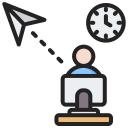Strategies for Boosting Remote Work Productivity
Chosen theme: Strategies for Boosting Remote Work Productivity. Welcome to a friendly, practical exploration of methods, mindsets, and tools that help you do meaningful work from anywhere without burning out. Share your routines in the comments and subscribe for weekly experiments that actually stick.
Designing a High-Performance Home Workspace
Position your monitor at eye level, keep wrists neutral, and set chair height so knees sit at ninety degrees. Schedule microbreaks to stand and stretch. These tiny safeguards prevent fatigue that steals focus. What ergonomic tweak helped you the most this month?
Routines that Reduce Friction
Start-up and Shut-down Scripts
Begin with a two-minute start-up: open calendar, write a three-line daily plan, and send one proactive check-in. End with a shut-down checklist. By scripting bookends, you shrink decision fatigue and reclaim focus. Share your favorite checklist item for others to borrow.
Timeboxing with Buffers
Block tasks on your calendar and protect five to ten minutes between boxes for bio breaks and notes. Many teams like a fifty-two on, seventeen off rhythm, or ninety-minute deep work cycles. What timebox size best fits your attention span? Compare notes with peers.
Anchor Habits and Triggers
Tie a habit to a reliable trigger: after making coffee, review priorities; after lunch, batch messages; after closing laptop, log wins. Stacking behaviors reduces willpower costs and makes momentum automatic. Tell us which trigger you chose this week and how it felt.
Write Once, Answer Many
Create a single, well-structured update with a summary, decisions needed, deadlines, and attachments. Link to source documents and tag owners. One thoughtful message prevents five chaotic threads. Try this format tomorrow and report whether your team’s response time actually improved.
Latency-Aware Collaboration
Match channels to urgency: issues within two hours go to chat; anything longer belongs in docs or tickets. Publish response-time expectations. This reduces anxiety and midnight pings. What communication norms could your team adopt this week to lower stress without slowing delivery?
Meeting Hygiene: Fewer, Faster, Focused
Schedule only when discussion truly requires synchronous debate. Provide agendas, outcomes, and a directly responsible individual. Default to twenty-five minutes. Record decisions in writing. Many teams reclaim whole days by pruning recurring meetings. Experiment for a month and share your before-and-after calendar.
Focus, Flow, and Cognitive Load
Reduce Switch Costs
Batch messages twice daily, collapse notification badges, and use one-tab mode during deep work. Context switching taxes working memory and derails momentum. UC Irvine research suggests resuming after interruption often takes more than twenty minutes. What interruptions could you eliminate tomorrow morning?
Attention Nutrition
Prioritize sleep, hydration, and protein-rich meals. Respect ultradian rhythms by clustering demanding tasks when your energy peaks. A brisk walk outdoors boosts mood and executive function. List your highest-energy hours below, and schedule your toughest work there for one week.
Mindful Breaks that Restore Depth
Use the twenty-twenty-twenty rule for eyes, two minutes of box breathing, or a quick stretch ladder. Breaks are not indulgences; they are refueling stops. Share your favorite microbreak recipe so others can test it during their next focused block.

Tools and Automation for Remote Velocity
Create templates for status updates, email responses, and pull requests. Use text expanders, rules, and automations to route files and assign tasks. Fatima saved three hours weekly by templating retrospectives. Which task will you automate today and how will you measure the gain?



